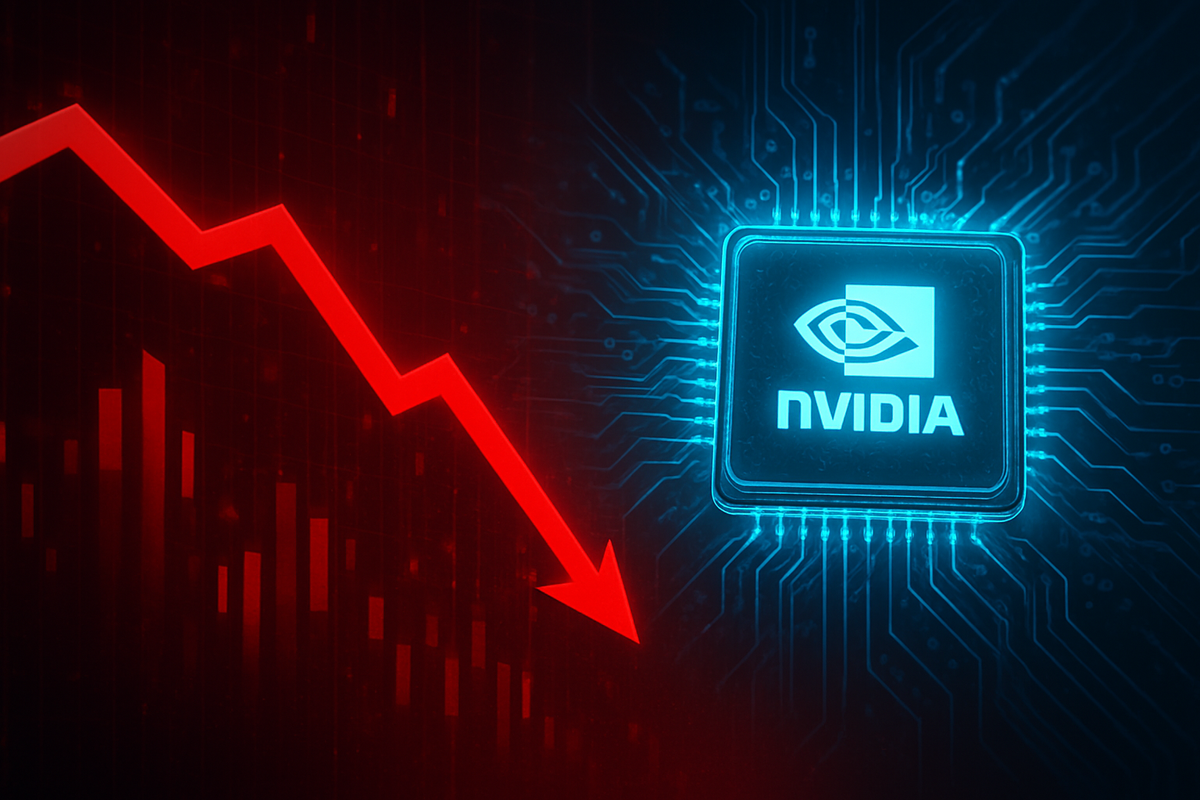
Nvidia (NASDAQ: NVDA), the undisputed titan of artificial intelligence (AI) chip manufacturing, has found itself in the unenviable position of being a "big loser" during recent stock market downturns, notably experiencing a sharp decline in early November 2025. This latest dip saw the company's market capitalization shed an estimated $800 billion in the first week of the month, a staggering sum that underscores the volatility inherent in even the most dominant tech stocks. While such a dramatic correction might signal deep-seated problems for other companies, for Nvidia, it highlights the intense scrutiny and sky-high expectations placed upon a company at the forefront of a transformative technological revolution.
The recent sell-off has ignited fresh debates among investors and analysts about the sustainability of AI valuations, the cyclical nature of the semiconductor industry, and the myriad of macroeconomic and geopolitical headwinds impacting global markets. Nvidia's significant role in powering the AI boom means its performance is often seen as a bellwether for the broader tech sector, making its recent struggles a topic of urgent discussion for MarketMinute readers.
Nvidia's Turbulent Trajectory: Unpacking Recent Declines
Nvidia's journey to becoming a multi-trillion-dollar company has been punctuated by periods of breathtaking ascent and equally sharp, though often temporary, retreats. The early November 2025 decline, where the stock plummeted over 7% in a single week, erasing roughly $800 billion in market capitalization, is the latest chapter in this volatile narrative. This downturn followed a pattern of significant corrections seen throughout 2024 and early 2025. For instance, in June 2024, the company rapidly lost approximately $500 billion off its market capitalization after briefly becoming the world's most valuable company. August and September 2024 also saw substantial drops, including a 9.5% single-day fall and a 20% loss since June 2024. The first quarter of 2025 was particularly challenging, with an 18.9% decline between January and April, pushing the stock to multi-month lows.
These significant pullbacks are often attributed to a confluence of factors. Concerns about Nvidia's (NASDAQ: NVDA) valuation reaching "bubble" territory in the AI market have consistently fueled profit-taking. Broader tech market downturns, often triggered by macroeconomic anxieties such as inflation fears, interest rate hikes, and general economic uncertainty, have also dragged Nvidia down. Geopolitical tensions, particularly the escalating trade restrictions between the US and China impacting advanced AI chip exports, have repeatedly created headwinds for the company. Furthermore, company-specific issues like investor concerns over slowing growth, reported production delays for its next-generation Blackwell AI chips in August 2024, and even CEO Jensen Huang's scheduled share sales in June 2024, have contributed to investor jitters.
Despite these sharp corrections, a consistent theme has been Nvidia's remarkable ability to rebound quickly. The stock often stabilizes and recovers lost ground, sometimes within days, as seen with a 5.79% increase on November 10, 2025, following the early November dip. This resilience is largely due to its foundational role in the AI ecosystem and the sustained demand for its high-performance GPUs. Key players involved in this dynamic include Nvidia's management, particularly CEO Jensen Huang, who navigates these challenges, and a vast network of institutional and retail investors whose sentiment drives the stock's movements. Initial market reactions are typically characterized by intense selling pressure followed by a period of reassessment, often leading to a stabilization or rebound as the underlying demand for AI technology remains robust.
Shifting Sands: Who Wins and Loses in Nvidia's Wake?
While Nvidia (NASDAQ: NVDA) is directly impacted by these downturns, the ripple effects extend across the technology landscape, creating both challenges and opportunities for various players.
Nvidia (NASDAQ: NVDA) itself undeniably experiences significant paper losses during these corrections. However, its long-term position as the market leader in AI hardware, particularly with its CUDA platform creating a powerful ecosystem lock-in, means it is often seen as a resilient "buy-the-dip" opportunity. The challenges include managing investor expectations, addressing production delays for critical products like the Blackwell chips, and navigating the complex geopolitical landscape surrounding chip exports.
Competitors stand to gain from any perceived weakness or vulnerability in Nvidia's dominance. Advanced Micro Devices (NASDAQ: AMD) has been aggressively accelerating its push into AI accelerators, offering alternatives that could capture market share. The emergence of Chinese startups like DeepSeek, reportedly offering comparable AI models at a reduced cost, also presents a competitive threat, particularly in markets where geopolitical restrictions might limit Nvidia's reach. Intel (NASDAQ: INTC) also continues to vie for market share in data center and AI segments, though it faces its own set of challenges.
Partners and Customers, primarily the hyperscalers such as Google (NASDAQ: GOOGL), Amazon (NASDAQ: AMZN), and Microsoft (NASDAQ: MSFT), are both beneficiaries and potential disruptors. They are massive buyers of Nvidia's GPUs, driving a significant portion of its revenue. However, these tech giants are also increasingly investing in designing their own custom silicon, aiming to reduce reliance on external suppliers and optimize chips for their specific AI workloads. This trend, if it accelerates, could pose a long-term threat to Nvidia's market share. Manufacturing partners like Taiwan Semiconductor Manufacturing Company (NYSE: TSM), which produces Nvidia's advanced chips, also experience direct impacts from changes in Nvidia's production schedules and demand forecasts.
The Broader AI Landscape: Trends, Ripples, and Precedents
Nvidia's recent stock volatility is not merely an isolated event; it is a microcosm of broader trends and tensions within the burgeoning AI industry and the global economy. The primary concern fueling these corrections is the lingering question of an "AI bubble." While the potential of AI is undeniable, investors are increasingly scrutinizing the massive capital expenditures in AI infrastructure against the actual, realized returns. Investment outfits estimated that while $50 billion was spent on Nvidia chips for AI training in 2024, only $3 billion in revenue had been delivered to date, highlighting the lag between investment and tangible financial outcomes. This disparity fuels fears of overvaluation and prompts market corrections when investor sentiment shifts.
The event also casts a spotlight on the cyclical nature of the semiconductor industry. Historically, periods of rapid growth in chip demand are often followed by oversupply or a slowdown, leading to price corrections and reduced revenues. While AI demand is a powerful new catalyst, the fundamental economics of chip manufacturing and procurement remain susceptible to these cycles. The geopolitical landscape further complicates matters. US-China trade restrictions on advanced AI chips, coupled with new tariffs imposed by the US administration on imports from Taiwan (where TSMC manufactures Nvidia's chips), create significant ripple effects across global supply chains. These policies not only impact Nvidia's ability to sell into key markets but also raise costs and introduce uncertainty for its manufacturing partners and customers worldwide.
Historically, the tech sector has witnessed similar periods of speculative fervor and subsequent corrections, such as the dot-com bubble of the late 1990s and early 2000s. While the underlying technology and market dynamics are different, the pattern of rapid valuation growth followed by sharp pullbacks due to overexuberance or economic shifts bears some resemblance. Nvidia itself experienced a significant downturn from late 2021 to October 2022, falling 66.4% during the "2022 Inflation Shock," only to fully recover by May 2023. This historical precedent offers a glimmer of hope for long-term investors, suggesting that fundamental strength and technological leadership can eventually overcome market turbulence.
What Comes Next: Navigating the Future of AI and Semiconductors
The path forward for Nvidia (NASDAQ: NVDA) and the broader AI and semiconductor markets is likely to be characterized by continued dynamism and potential volatility. In the short term, investors should brace for ongoing fluctuations driven by macroeconomic data, geopolitical developments, and the release of quarterly earnings reports from Nvidia and its peers. Any signs of sustained slowing in AI investment returns or further production delays could trigger additional sell-offs. Conversely, positive developments in chip manufacturing, new AI breakthroughs, or easing trade tensions could spark rapid rebounds.
In the long term, Nvidia will need to demonstrate strategic pivots and adaptations to sustain its growth trajectory. This includes effectively managing its supply chain to mitigate production delays, diversifying its revenue streams beyond core AI training chips (e.g., into inference, software, and enterprise solutions), and fiercely defending its CUDA ecosystem against emerging open-source alternatives and custom silicon from hyperscalers. The market opportunities remain immense, driven by the ever-expanding applications of AI across industries, from autonomous vehicles to drug discovery. However, challenges include intense competition from both established players and nimble startups, the ever-present threat of geopolitical intervention, and the need to manage sky-high investor expectations.
Potential scenarios range from a continued "AI supercycle" where demand for Nvidia's technology outstrips supply for years to come, leading to new highs, to a more tempered growth environment if the "bubble" deflates and investment slows. Another scenario involves a significant shift towards custom silicon by major tech companies, gradually eroding Nvidia's market dominance in certain segments. The outcome will largely depend on Nvidia's ability to innovate, execute, and adapt to a rapidly evolving technological and economic landscape.
Comprehensive Wrap-Up: Key Takeaways and Investor Outlook
Nvidia's recent classification as a "big loser" in market downturns, particularly the early November 2025 correction, serves as a potent reminder of the inherent risks and rewards in the high-stakes world of technology investing. The key takeaway is that even market leaders with seemingly unassailable positions are susceptible to broad market sentiment, macroeconomic pressures, and company-specific challenges. While the scale of Nvidia's market capitalization losses is striking, its quick rebounds often underscore the underlying bullish sentiment and the indispensable nature of its technology to the ongoing AI revolution.
Moving forward, the market will continue to scrutinize the sustainability of AI valuations, the pace of AI adoption, and the health of the semiconductor industry. Geopolitical developments, especially those concerning US-China trade relations and global supply chains, will remain critical factors influencing investor confidence. For Nvidia (NASDAQ: NVDA), its ability to innovate, address production bottlenecks, and fend off increasing competition will be paramount.
Investors should closely watch Nvidia's upcoming earnings reports for insights into demand for its next-generation chips, progress on production, and any strategic shifts. Monitoring competitor advancements, particularly from Advanced Micro Devices (NASDAQ: AMD) and the custom silicon efforts of hyperscalers, will provide clues about the evolving competitive landscape. Furthermore, keeping an eye on broader economic indicators and central bank policies will be crucial, as these factors often dictate the overall direction of the tech sector. While Nvidia's journey will undoubtedly be marked by continued volatility, its pivotal role in the AI era suggests that its long-term trajectory remains compelling for those with a high tolerance for risk and a belief in the transformative power of artificial intelligence.
This content is intended for informational purposes only and is not financial advice





